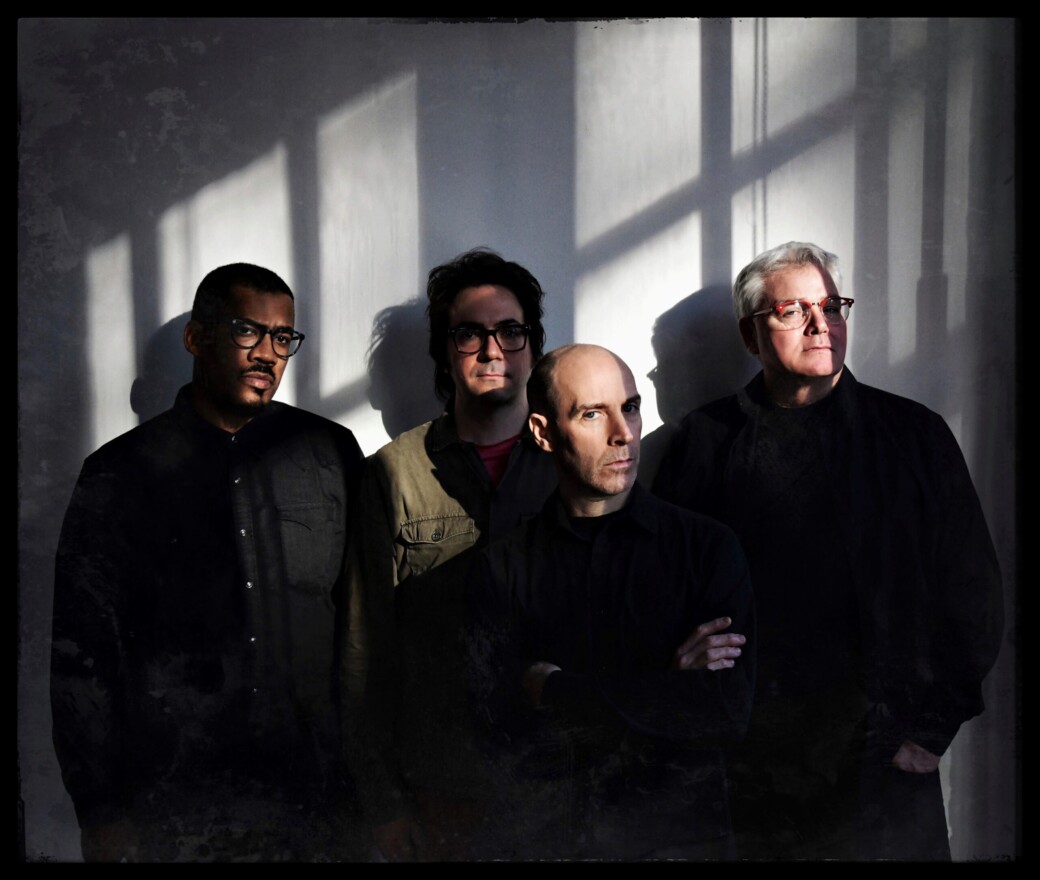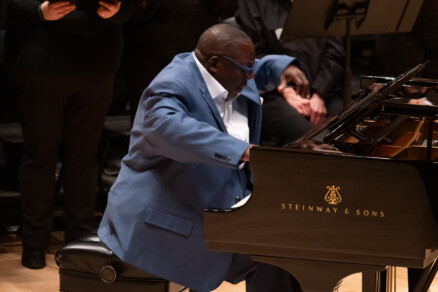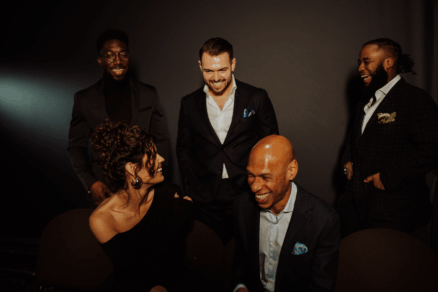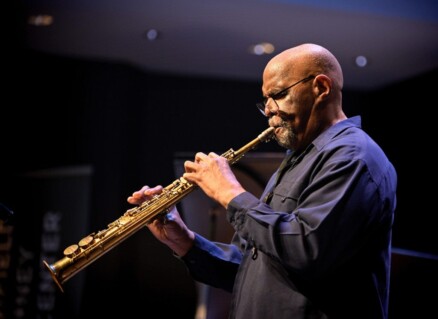The Messthetics and James Brandon Lewis are ‘chasing energy,’ not genre, on powerful new LP

For the members of D.C.-based pyrotechnic rock trio the Messthetics and luminary tenor saxophonist James Brandon Lewis, the question was not “will” or “can” we collaborate, but “when?” As bassist Joe Lally put it in a recent conversation, “How could we not?”
Made up of Lally and drummer Brendan Canty — both alumni of the legendary postpunk quartet Fugazi — along with guitar virtuoso Anthony Pirog, the Messthetics were already linked to the Brooklyn-based Lewis, via Pirog. The saxophonist and the guitarist had met as part of a group that was put together by the legendary drummer William Hooker. Pirog then went on to make appearances on Lewis’s own albums, No Filter (2017) and An UnRuly Manifesto (2019).
The seemingly inevitable Messthetics-Lewis collaboration finally came to fruition in early 2019, when the trio shared the stage with Lewis at NYC Winter Jazzfest. From then on, Lewis would join the Messthetics onstage whenever they played Brooklyn.
This month, the collaboration finally came to a head with the release of an already-critically acclaimed full-length LP, The Messthetics and James Brandon Lewis, on the storied Impulse! label.
Lally said those early collaborative performances in New York alerted the group to just how organic and natural their music could feel as a quartet, in terms of both sound and energy — even when compared with other successful onstage collaborations, as when the Messthetics played alongside Chicago iconoclast Ken Vandermark. When Lewis teamed up with the trio, it felt like “you have something that sounds like a band, as opposed to a put-together project,” the saxophonist observed.
This realization drove the quartet to enter the studio (Takoma Park’s own Tonal Park) to record a full-length of original music, written with their new sound at the center.
After spending last spring touring together as a double-bill — with Lewis fronting a trio of his own — Lewis and the Messthetics have now set off on a tour that will bring the four-piece across the U.S. and Europe (including a stop at the beloved Big Ears Festival in Knoxville, Tenn., this weekend), and home to D.C. for a show at the Black Cat on Friday, March 29.
CapitalBop spoke to Lewis, Pirog, Lally and Canty by Zoom on Tuesday, digging into their collaborative and creative process, and discussing why this inevitable collaboration has worked so well. Throughout the conversation, what shone through was a sense of mutual admiration — especially between Pirog and Lewis — and of joy at having found a creative partnership that’s both so seamless and catalytic.
CapitalBop: I wanted to start by asking the Messthetics, and especially Brendan and Joe, for y’all D.C. kids who grew up putting out your albums through labels like Dischord, what’s it like seeing your band name on that classic Impulse! label?
Joe Lally: It’s pretty mind-blowing. I’m a big fan of Alice Coltrane and Pharoah Sanders and John Coltrane, and other artists that are on there. At the same time, it’s hard because I’ve had my whole musical life on Dischord. It’s hard to see that I’m not [on it anymore]. Brendan’s probably there too: We’re always connected to Dischord. We’re just taking this little adventure on this insanely classic jazz album label.
Brendan Canty: It’s the power of collaboration, right? This is that, as well. Teaming up with Anthony changed our lives in a huge way, and now teaming up with James is changing our lives in a huge way…. It is an otherworldly experience, having spent your whole life collecting records that came out on Impulse! and digging into them and knowing they have put out some of the greatest music that has ever existed. I know that the people running it are really beholden to that legacy…. The fact they wanted to put out our record is really flattering.
CB: So, Anthony and James, you played together in a couple of James’s very D.C.-centric releases, like No Filter and An UnRuly Manifesto, but talk about how this really kind of came together. How did the collaboration start?
James Brandon Lewis: My interest in music is varied. I first got introduced to the worlds of this melting pot of avant-garde and punk rock via meeting Matthew Shipp in 2011, and learning he had collaborated with Henry Rollins and so many others — not even just punk rock, but he collaborated with poets like Anne Waldman. Having met Lydia Lunch and Thurston Moore, and my own experience at Naropa in Colorado, doing literary stuff … I’m always chasing energy, I’m not necessarily chasing genres. One example is my trio album that I made with Jamaaladeen Tacuma and Rudy Royston and a tune that I wrote for my dad entitled “Lament for JLew.” It’s really hitting on all cylinders and really has the same punk rock energy.
But I get tired of all these genres. Basically, I’m into playing like it’s my last time playing and that’s what the three of these folks on this phone call do. So, we made a record that represents such.
Anthony Pirog: By the first time the four of us played, I had known James for almost five years and we had been playing as a trio for just two years. I had toured with James and we had … actually recorded…. Basically, I was just excited to hear all four of us collaborate at Winter Jazzfest in 2019, because I knew that it would be an elevating experience for everyone — because like James says, everyone comes ready to play with a lot of energy and a lot of intensity.
Once we got through the initial collaboration, and we started playing more when the Messthetics were in New York City, it was just exciting to see what was possible with a full set of original, new material.
JL: And enlightening it was. Doing that, having James join us on the Winter Jazzfest shows in January 2019 for a few songs, that was exactly what I guess I would have hoped it to be. I had always wanted to hear what that would sound like. I didn’t know James’s background at the time, and just knew that Anthony had a history with him. And if [Anthony] was introducing [James] to what we were doing, then it was a good idea. And it was — it felt great! It really opened the door to new possibilities.
BC: When James was sitting in on that stuff live, that was all our older tracks. But this [new] record was really written more towards James’s involvement, and I think that’s a real crucial distinction that should be made. Also, “Fear Not,” the first record we ever recorded in the studio together, was for James’ record and that was a real template for how we could actually work in the studio together…. Once we had this idea in our brains, and James said yes to the potential of recording, it’s like: “Okay. So, what’s the potential here? How can we structure this?” Knowing what James could do, which is anything, let’s just take the training wheels off.
CB: I wanted to circle back to talking about the writing process. How did it differ from previous creative cycles?
JL: I think we would all agree that it turned out the way it did because we were writing specifically towards James and what James could do: It’s very particular to the person that you have in mind. I think things sound the way they do because we could hear him taking part in it, even though we had no idea what it would be. Part of it is just understanding what James can do and trusting him as a member…. It’s kind of an amazing record on that level because we trusted him to fill in [with] what we felt was unique to James. It really paid off, because everything we left open he filled in, in a way that just sounded obvious to us. Of course he’s going to do the very best thing possible there. We knew he would.
JBL: Okay, let’s start telling the truth, okay?
[All laugh]AP: It was an interesting way to work up a record, because the three of us were working up the arrangements and we were leaving space for James. It differed from previous Messthetics writing sessions because we were trying to fill up the space as a guitar trio, and this was going to be geared more towards featuring soloists and improvisations. We also could use different kinds of arranging techniques, like on “L’Orso,” when we start by trading the melody. It was interesting to me because for someone listening to that for the first time, it might be unclear if we’re improvising or playing a melody. Then, when we both come in the second time through, it’s established as the melody. Like Joe said, to watch James compose some of these things in real time, or at the rehearsal before the session, was really inspiring.
CB: Brendan and Joe, can you talk about your approach as a rhythm section on this record, and how it differs from your past work?
BC: I think if Anthony and James have a lot to say, we can be more of the rhythm section, honestly. On some of the other Messthetics records, and live, I always think we all have to kind of “push, push, push, push” all the time…. I think that with this record it feels way more like we can be a rhythm section and take some time to let some space happen and settle in for a long groove.
JL: I think I was very clear in understanding what my role was because somehow you could just see what everyone’s place was.
‘If you find a musical compatriot and you can fit your sound in theirs, I think that’s something special that you have to continue to explore, because it doesn’t happen often.’
— James Brandon Lewis, on Anthony Pirog
CB: On the other side, Anthony and James, could you elaborate on that melodic and compositional collaboration between you two? It does feel like you frequently mirror each other and play off each other like that. But if that was not the intent, then how did it all fall into place?
JBL: I think that me and Anthony have a similar melodic approach. Our ideas are different but the way we think about melody is the same. Our sounds kind of fit inside each other, which is interesting. I listen to the record and I’m like, “Am I playing?” And then I go, “Oh yeah, I’m there.” It’s easier to play with Anthony. If you find a musical compatriot and you can fit your sound in theirs, I think that’s something special that you have to continue to explore, because it doesn’t happen often.
AP: I agree with that, totally. It’s not like we discuss it. For instance, on “That Thang,” I’m using a very intense fuzz pedal during the melodies, but it blends with the sound that James is creating pretty well. Like, sometimes — like James said — I can’t really tell the difference between the timbres. The blend isn’t something we discussed or even planned, it’s just that I like a distorted sound and it works.
CB: It’s like Joe was saying earlier, it’s just “natural.”
JBL: It’s natural. There are moments too when I also think about the fact that this record allowed me to — because everyone was bringing ideas — tap into a version of myself that I don’t normally get to tap into. It’s not that I’m not necessarily not hearing music that way. But [on] “Three Sisters” … you’re not just getting, like, a raucous kind of sound; you’re getting intimate vulnerability. Then, by the time we end the track, just like on “Boatly,” we are basically at church at the end of the song. I think it’s been nice to explore so many different timbres and get to hear Anthony and get to hear Joe. Even some of the rhythms, the places that they go, I’m like: “This is cool, I’ve never soloed over this kind of rhythm.”
AP: I’d like to add that on “Three Sisters,” that was the first song that we were playing as a trio after lockdown and stuff was over. When I wrote that melody I was actually thinking of you, James. It made me think of something you would hum.
BC: My favorite moment was in the rehearsal for the last Winter Jazzfest, a few weeks ago. We were playing that song and one of you looked over at the other one and just goes, “What key are you playing in?”
[All laugh]You motherfuckers recorded this record, have been playing this song, and you don’t know what key you’re playing in? They’re soloing over each other and don’t even know what key they’re in!
AP: Brendan, we agreed we didn’t need to talk about this!
JBL: Exactly, exactly! We just started playing, right?
BC: That killed me! That’s how good they are.
The Messthetics and James Brandon Lewis play the Black Cat on Friday, March 29. More info and a link to buy tickets are at capitalbop.com/calendar.
Brendan Canty, DC, DC jazz, James Brandon Lewis, jazz, Joe Lally, The Messthetics, Washington




